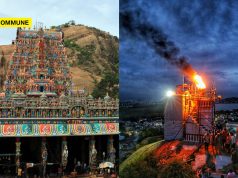
As we understand, Earth’s Moon has its ‘near side’ which is facing to the Earth and ‘far side’ which is away from earth. The composition of the Moon’s ‘near side’ is oddly different from its ‘far side’, and scientists now think that they have finally understood why it is so.
The Earth-Moon system’s history remains mysterious. Scientists believe when a Mars-sized body collided with the proto-Earth, the two were formed. Earth retained the heat whereas Moon ‘froze’. However, it offers many observable features keeping the scientists busy. Most planets of the solar system have satellites. Mars has 2, Jupiter has 79, and Neptune has 14, all with different characteristics. The formation of satellites has always been a part of the study.
Moon is relatively cold with a limited amount of water and little tectonic processing. Observable features of the Moon gives a clue of the difference in ‘near’ and ‘far’ side. Till a point in time, the patches seen on the perpetually facing near side was thought to be seas. Early astronomers had names these ‘maria’ (latin for seas). Using telescopes it was found that they were craters. It was assumed the ‘far side’ would also be the same. From the first images of the USSR space probe launched in the late 1950s and early 1960s, it was found that there is only 1% of craters or volcanic features on the ‘far side’ as compared to 31% on the ‘near.’ In late 1960s and early 1970s, NASA Apollo Mission scientists brought 382 kgs of moon rocks for studies. Scientists figured out the relative darkness of these patches were due to their geological composition and they were, in fact, attributable to volcanism.
A new type of rock named KREEP (K is chemical name for potassium, REE – Rare Earth Elements that includes Cerium, Dysprosium, Erbium, Europium, and other minerals rare on earth, P – Phosphorus). But it perplexed scientists as to why where they unevenly distributed between the far and near sides of the moon.
Scientists at the Earth-Life Science Institute at Tokyo Institute of Technology, University of Florida, Carnegie Institution for Science, Towson University, University of Mexico, and NASA Johnson Space Centre have got some clues about this asymmetry using observations, lab experiments and computer modelling and have traced it to an important property of KREEP. They had conducted high temperature melting experiments on rocks with various KREEP components and studied the implications of volume and timing of volcanic activity at the lunar surface.
Potassium (K), Thorium (Th), and Uranium (U) are radioactively unstable and exist in different atomic combinations with differing number of neutrons. These varying combinations of the same element are called isotopes. The unstable isotopes break and give rise to new elements producing heat in the process. This heat due to the radioactive decay can melt rocks in which they are contained in.
Presence of KREEP in rocks lowers their melting temperatures in addition to enhanced heating, compounding the expected volcanic activity from simply radiogenic decay models. This study also places constraints on the timing of Moon’s evolution and the order in which various processes occurred on the moon. The study suggests that Moon’s KREEP-enriched maria have influenced evolution of the Moon.
The Moon’s near side have high concentrations of U and Th unlike any other place on the moon. Understanding the origin of these local U and Th enrichments will help explain early stages of moon’s formation and also conditions of early earth.




